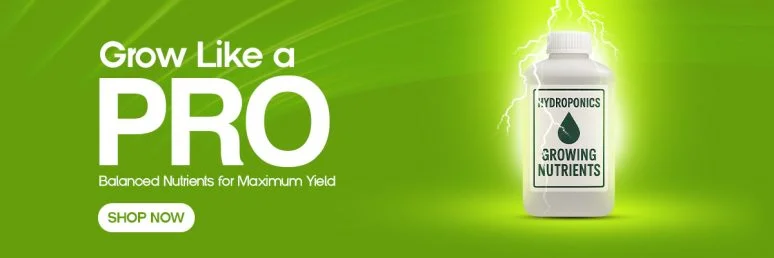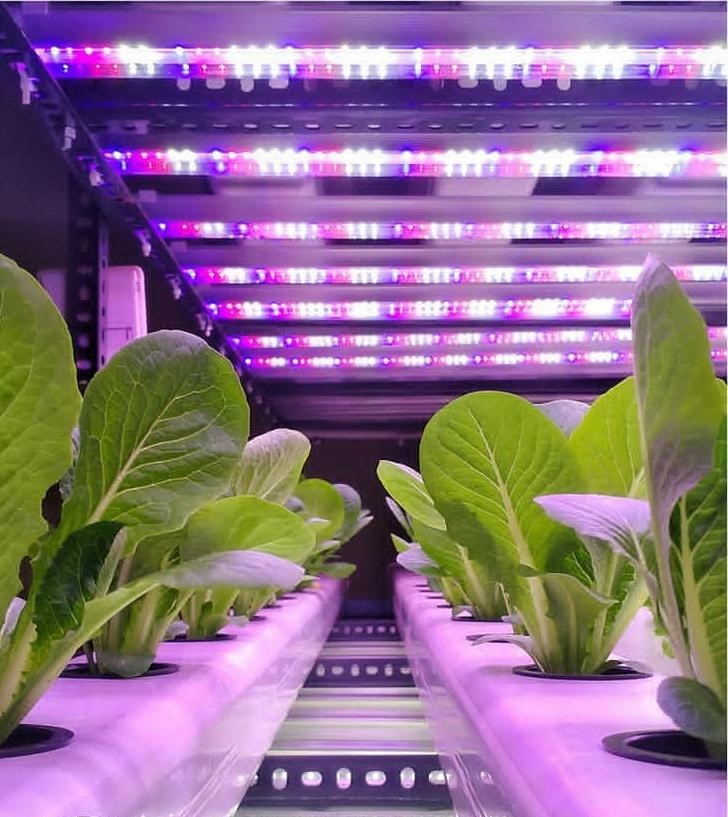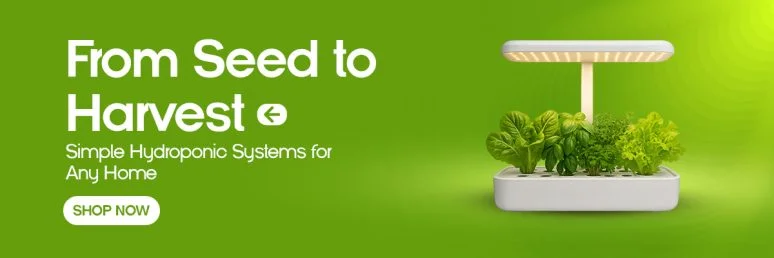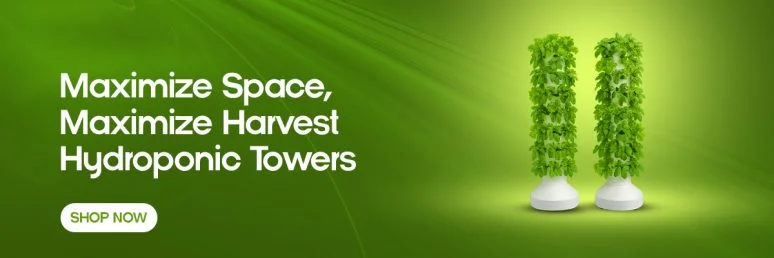4 Easy Steps to Growing Hydroponic Lemon Trees: Starter Tips
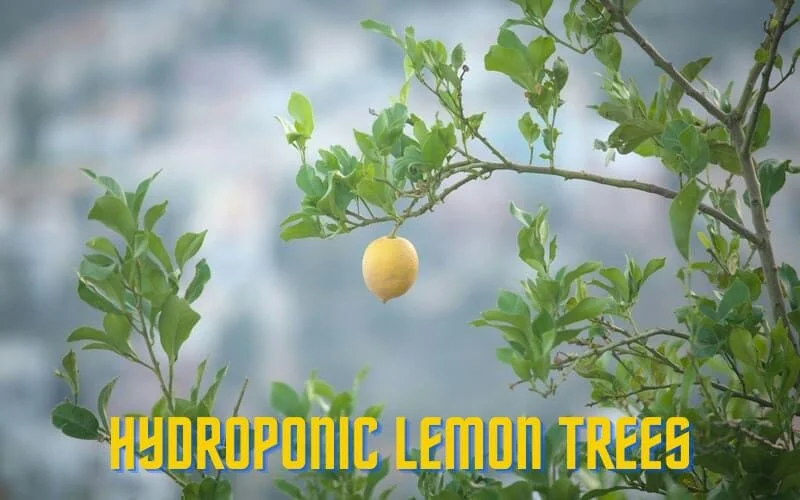
Key Takeaways
- Hydroponic lemon trees can be successfully grown indoors with proper lighting, nutrients, and system setup – even producing fruit in as little as 2-3 years.
- Meyer lemons are the ideal variety for hydroponic beginners due to their compact size, adaptability to indoor conditions, and sweeter fruit profile.
- Deep Water Culture (DWC) systems offer the simplest setup for novice hydroponic citrus growers, requiring minimal maintenance while providing excellent oxygenation.
- Citrus-specific nutrients with higher potassium and micronutrient levels are essential for healthy growth and fruit production in soilless systems.
- Strategic pruning and hand-pollination techniques can significantly increase fruit yields in indoor hydroponic lemon trees.
Why Hydroponic Lemon Trees Are the Perfect Indoor Project
“Hydroponic lemon tree looking healthy …” from www.reddit.com and used with no modifications.
Growing lemon trees hydroponically indoors opens up possibilities that traditional soil gardening simply can’t match. By eliminating soil, you gain precise control over nutrients, significantly reduce pest problems, and can grow citrus year-round regardless of your climate. Hydroponic systems deliver nutrients directly to the roots, accelerating growth and often resulting in healthier trees that can produce fruit earlier than their soil-grown counterparts. The space efficiency of hydroponics means you don’t need a large yard or garden plot – a sunny window or grow light setup in any room can become your personal citrus grove.
I’ve seen hydroponic lemon trees thrive in apartments, basements, and even office spaces, bringing Mediterranean sunshine to otherwise impossible growing environments. The process combines the satisfaction of traditional gardening with the precision of modern technology, creating a rewarding hobby that yields tangible, delicious results. Plus, there’s nothing quite like harvesting fresh lemons from your own indoor tree in the middle of winter!
Step 1: Choose the Right Lemon Variety for Hydroponics
“Hydroponic Lemon Tree monthly update …” from www.reddit.com and used with no modifications.
Selecting the appropriate lemon variety is crucial for hydroponic success, as some types are much better suited to container growing than others. While all citrus can technically be grown hydroponically, those with naturally compact growth habits will require less maintenance and adapt more readily to indoor conditions. Your choice will affect everything from the space needed to the flavor of your harvest, so it’s worth taking time to research options before getting started.
Meyer Lemons: The Top Choice for Beginners
Meyer lemons stand out as the gold standard for hydroponic beginners due to their naturally dwarf growth habit and exceptional adaptability to indoor conditions. These trees rarely exceed 6-8 feet when mature (and can be kept smaller with pruning), making them ideal for home hydroponic systems where space is often limited. What makes Meyer lemons particularly appealing is their fruit quality – they produce thin-skinned, sweeter lemons with less acidity than standard grocery store varieties, often described as having a slight mandarin orange flavor profile. Their compact root system adapts well to hydroponic setups, and they’re more forgiving of slight variations in nutrient levels than other citrus varieties.
Meyer lemons also offer faster gratification than most citrus, potentially producing their first fruits within 2-3 years when grown hydroponically under optimal conditions. I’ve found they respond particularly well to artificial lighting, maintaining healthy growth even without direct sunlight. As a bonus, their fragrant white blossoms fill your growing space with an intoxicating scent before fruit development begins.
Other Suitable Citrus Varieties
Beyond Meyer lemons, several other citrus varieties can thrive in hydroponic systems with proper care. Dwarf varieties of Eureka and Lisbon lemons perform well in controlled environments, though they produce more acidic fruits than Meyer lemons. For those seeking variety, dwarf lime trees – particularly Key limes and Kaffir limes – adapt excellently to hydroponic systems and offer unique culinary uses. Calamondin oranges, with their small size and ornamental appeal, make attractive hydroponic specimens that produce small, tangy fruits useful for cooking or garnishing drinks. If you’re interested in learning more about starting a hydroponic garden, check out this easy guide.
For more adventurous growers, kumquats and limequats can be successfully grown hydroponically, providing interesting variations in flavor profiles. Whatever variety you choose, look specifically for genetic dwarfs or trees labeled as container-friendly, as these will naturally maintain a manageable size without extensive pruning. Avoid standard-sized citrus varieties, as their vigorous growth quickly becomes unmanageable in indoor hydroponic systems.
Where to Source Quality Seeds or Cuttings
Starting with high-quality genetic material dramatically improves your chances of hydroponic success. While growing from seed might seem tempting, it’s important to note that most commercially available lemons produce seedlings that don’t match the parent fruit’s characteristics. Additionally, seed-grown trees typically take 7-10 years to bear fruit, even in optimal hydroponic conditions. Instead, I recommend purchasing a small grafted tree from a reputable nursery specializing in citrus – these trees have already been propagated from mature, fruit-bearing specimens and will produce fruit much sooner.
Specialized online citrus nurseries like Four Winds Growers or Nature Hills offer dwarf citrus varieties that transition well to hydroponic systems. Local nurseries in USDA zones 8-11 often carry suitable potted citrus plants during spring months. When selecting a tree, look for healthy specimens 1-2 feet tall with vibrant green leaves and no signs of pest damage. For those comfortable with more advanced propagation techniques, air-layering from an existing healthy tree provides genetically identical plants that adapt well to hydroponic conditions – just ensure you’re propagating from a dwarf variety to maintain manageable size.
Step 2: Set Up Your Hydroponic System for Citrus Success
“Hydroponic Lemon Tree From Seed : r/Citrus” from www.reddit.com and used with no modifications.
Creating the right hydroponic environment for lemon trees requires careful consideration of their specific needs. Unlike leafy greens or herbs that thrive in simple systems, citrus trees have deeper root systems and longer lifespans that demand more thoughtful setup. The good news is that once properly established, a well-designed hydroponic system for lemons requires relatively little maintenance while providing ideal growing conditions year-round.
Deep Water Culture vs. Nutrient Film Technique for Citrus
When it comes to hydroponic systems for lemon trees, Deep Water Culture (DWC) typically outperforms other methods for home growers. In a DWC system, your tree’s roots hang directly into an oxygenated nutrient solution, promoting rapid growth and excellent nutrient uptake. This approach works particularly well for citrus because it provides consistent moisture while preventing the waterlogged conditions that can damage roots. For beginners, I recommend a modified DWC setup with a 10-15 gallon reservoir to accommodate growing roots and provide buffer against rapid pH or nutrient fluctuations.
While Nutrient Film Technique (NFT) systems excel for smaller plants, they generally aren’t ideal for citrus trees whose substantial root mass can clog channels and whose longevity exceeds the typical lifespan of NFT components. Drip systems represent a middle ground, offering good results for intermediate growers willing to manage more complex equipment. Whatever system you choose, prioritize sturdy construction and accessibility for maintenance – you’ll be managing this setup for years as your tree matures and produces fruit. For those interested in optimizing their hydroponic setup, understanding the best growing medium for hydroponics can be crucial for success.
Container Size Requirements for Lemon Trees
Container sizing plays a crucial role in long-term hydroponic lemon success. Start young trees in a container with at least 5 gallons of capacity, allowing ample space for early root development without overwhelming the plant. As your tree matures, be prepared to transplant to progressively larger containers – a producing dwarf Meyer lemon will ultimately need 15-20 gallons to reach its full potential. The container should be opaque to prevent algae growth, with a secure lid that supports the tree while allowing the root system to access the nutrient solution below.
Depth matters more than width for citrus containers, as lemon trees develop tap roots that appreciate vertical space. When selecting or building your system, incorporate at least 12 inches of root zone depth for young trees, increasing to 18-24 inches for mature specimens. Remember that inadequate container sizing is among the most common causes of stunted growth and poor fruiting in hydroponic citrus – investing in appropriate sizing from the start saves considerable frustration later.
Essential Equipment Checklist
- Air pump and air stones: Robust oxygenation is non-negotiable for healthy citrus roots; choose a pump rated for at least twice your reservoir volume
- pH testing kit or meter: Digital options provide greatest accuracy for monitoring the critical pH range
- EC/TDS meter: Measures nutrient concentration to prevent over or under-feeding
- Quality grow lights: Full-spectrum LEDs with at least 300W actual draw for fruiting trees
- Timer: Automates lighting cycles and potentially nutrient circulation
- Thermometer: Monitors ambient temperature in your growing area
- Backup air pump: Provides insurance against pump failure, which can damage roots within hours
- Pruning shears: High-quality, sterilizable tools for maintaining tree shape
Best Growing Mediums for Citrus Roots
The ideal growing medium for hydroponic lemon trees balances moisture retention with aeration while providing sturdy support for the developing tree. Expanded clay pellets (LECA) stand out as the preferred medium for citrus, offering excellent drainage, reusability, and root support without compacting over time. For best results, rinse new clay pellets thoroughly to remove dust before use, and consider a mixture of smaller and larger pellets to create ideal root conditions. For more on maintaining optimal conditions, explore our guide on grow tent temperature and humidity control.
Coconut coir represents another excellent option, particularly when blended with perlite in a 70/30 ratio to improve aeration. This combination retains sufficient moisture between feedings while maintaining the oxygen levels crucial for healthy citrus roots. Avoid rockwool for citrus trees despite its popularity for other crops – its tendency to retain excessive moisture can promote root disease in longer-living plants like lemons. Whichever medium you select, ensure it’s contained in a net pot or mesh container that allows roots to extend into the nutrient solution while keeping the medium in place.
Step 3: Perfect Your Nutrient Solution for Thriving Lemon Trees
“What is a dwarf citrus?” from www.pinterest.com and used with no modifications.
The nutrient solution forms the lifeblood of your hydroponic lemon tree, delivering everything it needs for growth, flowering, and fruit production. Unlike soil, which can buffer imbalances, hydroponic systems require precise nutrient management. Taking time to understand and perfect your feeding program pays enormous dividends in tree health and productivity over years of growth.
Citrus-Specific Nutrient Needs
Lemon trees have distinct nutritional requirements that differ from common hydroponic crops like lettuce or tomatoes. While standard hydroponic nutrients provide a starting point, citrus trees require higher levels of nitrogen during vegetative growth phases, transitioning to increased potassium and phosphorus during flowering and fruiting. Micronutrient needs are particularly important – citrus is sensitive to deficiencies in magnesium, iron, zinc, and manganese that may not affect other hydroponic plants. I’ve found that specialized citrus-focused nutrients like General Hydroponics CitrusMicro or custom-blended solutions specifically formulated for woody perennials deliver superior results compared to standard hydroponic formulations.
pH Range for Optimal Nutrient Absorption
Maintaining the correct pH level is absolutely critical for hydroponic citrus success, with the ideal range being slightly acidic at 5.5-6.5. At this pH range, lemon trees can efficiently access all essential macro and micronutrients from the solution. When pH drifts above 6.5, iron and manganese become less available, often resulting in telltale yellowing between leaf veins (chlorosis) that indicates deficiency despite adequate nutrients being present in the solution.
Daily pH monitoring is essential, particularly in smaller systems where changes can occur rapidly. Use food-grade pH adjusters (phosphoric acid to lower pH, potassium hydroxide to raise it) rather than industrial options, making small incremental changes rather than dramatic corrections. Stability matters more than hitting an exact number – a consistent pH of 6.2 will yield better results than one that bounces between 5.5 and 6.5 regularly.
Water Temperature and Quality Considerations
The temperature of your nutrient solution significantly impacts how well lemon tree roots can absorb nutrients and oxygen. Maintain your reservoir between 65-75°F (18-24°C) for optimal results – cooler temperatures slow nutrient uptake and metabolism, while warmer solutions hold less dissolved oxygen and can promote pathogen growth. During summer months, you may need to use frozen water bottles rotated through the reservoir or install a small aquarium chiller to maintain appropriate temperatures.
Water quality forms the foundation of your nutrient solution and can make or break your hydroponic citrus success. Start with filtered water or allow tap water to sit for 24 hours to allow chlorine to dissipate before adding nutrients. If your tap water exceeds 200 ppm in total dissolved solids (TDS) or has high sodium content, consider using reverse osmosis filtered water to provide a clean slate for your nutrient formulation. Hard water with high calcium and magnesium levels can throw off nutrient balances and create precipitation issues that clog systems over time.
Nutrient Solution Maintenance Schedule
For healthy hydroponic lemon trees, implement a regular maintenance schedule that includes weekly partial solution changes (replacing 25-30% of the reservoir volume) and complete reservoir cleaning every 4-6 weeks. Monitor electrical conductivity (EC) daily, maintaining readings between 1.8-2.2 for mature trees, with slightly lower values (1.5-1.8) during vegetative growth phases. Rather than topping off with full-strength nutrient solution as levels drop, use plain pH-adjusted water for daily top-offs and reserve nutrient additions for when EC readings drop below target range, preventing harmful salt buildup in the system. For more tips on maintaining a hydroponic system, explore our hydroponic herb garden tips.
Nutrient Solution Maintenance Schedule
For healthy hydroponic lemon trees, implement a regular maintenance schedule that includes weekly partial solution changes (replacing 25-30% of the reservoir volume) and complete reservoir cleaning every 4-6 weeks. Monitor electrical conductivity (EC) daily, maintaining readings between 1.8-2.2 for mature trees, with slightly lower values (1.5-1.8) during vegetative growth phases. Rather than topping off with full-strength nutrient solution as levels drop, use plain pH-adjusted water for daily top-offs and reserve nutrient additions for when EC readings drop below target range, preventing harmful salt buildup in the system. If you’re new to this, check out some beginner tips for growing lemon trees hydroponically.
Seasonal Nutrient Adjustments for Lemon Trees
Spring: Higher nitrogen (N) for leaf growth – EC 1.8-2.0
Summer: Balanced N-P-K formula – EC 2.0-2.2
Fall: Increased potassium for fruit development – EC 2.0-2.2
Winter: Reduced overall concentration – EC 1.5-1.8
I’ve found that incorporating organic supplements like seaweed extract (for micronutrients) and humic acid (to improve nutrient availability) every other week can significantly enhance tree health and fruit quality. Just be sure these additions don’t clog air stones or pumps by pre-diluting them thoroughly before adding to your system.
Step 4: Master Light, Pruning and Pollination Techniques
“Hydroponics Grow Light – Red blue …” from www.wehydroponics.com and used with no modifications.
Even with perfect nutrients, hydroponic lemon trees need proper light, structural management, and pollination to thrive and produce fruit. These three elements work together to create the conditions for abundant harvests and healthy growth patterns that keep your tree productive for years.
Light Requirements Throughout Growth Stages
Lemon trees are high-light plants that require significantly more intense illumination than many common hydroponic crops. For healthy growth and fruiting, provide 10-14 hours of bright light daily, with a minimum of 30-40 watts of actual LED power per square foot of canopy. Position lights to provide even coverage across the entire tree, adjusting height as your tree grows to maintain 12-18 inches between upper leaves and light fixtures. Commercial LED grow lights designed for flowering plants work well, particularly those with enhanced blue and red spectrum that support both vegetative growth and flowering/fruiting processes. To learn more about how big your hydroponic plants can get, visit this guide on hydroponic plant growth.
If supplementing natural window light, position your hydroponic setup in a south-facing window and use grow lights to extend daylight hours or boost intensity during cloudy periods. During winter months, increase artificial lighting to compensate for reduced natural light intensity and shorter days. Watch for light stress symptoms – leaves curling upward or developing sunburn-like patches indicate too much light, while stretched, sparse growth suggests insufficient illumination. For more tips, consider reading about hydroponic herb garden tips to optimize your setup.
Strategic Pruning for Bushy, Productive Trees
Proper pruning transforms a spindly lemon sapling into a compact, productive tree that fits comfortably in your hydroponic system. Begin shaping young trees early by pinching the growing tip when they reach about 12 inches tall to encourage lateral branching. Once established, prune to maintain an open, vase-shaped structure that allows light penetration throughout the canopy. Remove inward-growing branches that cross the center of the tree, along with any damaged or diseased growth, making clean cuts just above leaf nodes to promote healing.
Unlike outdoor citrus that may only need annual pruning, hydroponic specimens benefit from lighter, more frequent trimming to maintain appropriate size. I’ve found that removing no more than 20% of foliage in any single pruning session prevents stress while gradually shaping the tree. Prioritize air circulation through the canopy, as humid pockets of still air between densely packed branches can harbor pests and diseases that are otherwise rare in hydroponic environments.
Hand-Pollination Methods for Indoor Fruit Production
Without natural pollinators indoors, you’ll need to manually transfer pollen between flowers to ensure fruit set on your hydroponic lemon tree. When your tree blooms (typically producing small, fragrant white flowers), use a small, soft paintbrush or clean cotton swab to gently brush the center of each open flower, moving from flower to flower. The goal is to transfer the powdery yellow pollen from the stamens (male parts) to the sticky pistil (female part) in the center of each flower. For best results, pollinate during the warmest part of the day when pollen is most viable, and repeat the process every other day throughout the blooming period.
Don’t be alarmed if your tree drops many flowers even after pollination – citrus naturally sheds excess blossoms to focus energy on developing a manageable number of fruits. If flowering occurs but no fruits develop, check humidity levels – overly dry air can prevent pollen viability, so consider running a humidifier near the tree during flowering or misting around (not directly on) the blossoms to increase local humidity.
Pest Prevention in Soilless Systems
One major advantage of hydroponic citrus growing is significantly reduced pest pressure compared to soil cultivation. However, certain pests can still find their way to your indoor lemon tree. Spider mites, aphids, and scale insects remain the most common invaders, typically entering on new plants or through open windows. Implement a weekly inspection routine, checking leaf undersides and stem joints where pests first appear, and treat any findings immediately before populations explode. For more on keeping your indoor environment optimal, explore our guide on grow tent temperature and humidity control.
For organic pest management, I recommend neem oil applications (diluted per package directions) every 7-10 days at the first sign of trouble, ensuring complete coverage of all plant surfaces including leaf undersides. Beneficial insects like ladybugs or predatory mites can also be introduced for ongoing biological control in larger indoor growing spaces. Maintain good air circulation with a small fan near your tree to create an environment less favorable to pests and diseases – just ensure the breeze isn’t strong enough to damage flowers during blooming periods.
What to Expect: Growth Timeline and Fruit Production
“Hydroponic Lemon Tree” from www.bitponics.com and used with no modifications.
Understanding the growth patterns and timeline of hydroponic lemon trees helps set realistic expectations and prevents discouragement during the establishment period. While hydroponic systems can accelerate growth compared to soil cultivation, citrus remains a patient gardener’s project that rewards long-term commitment.
First Year Milestones
During the first year in your hydroponic system, focus on establishing healthy root structure and vegetative framework rather than fruit production. A properly maintained tree should produce multiple flushes of new leaves throughout the year, with bright green, glossy foliage indicating good nutrient uptake. Root development becomes visible as white, healthy roots extend through net pots into the nutrient solution below. By 6-8 months, young trees typically reach 2-3 feet in height with multiple branches forming a balanced canopy structure. For more guidance, check out these beginner tips for growing lemon trees in hydroponic systems.
First-year flowers should actually be removed to direct energy toward establishing strong vegetative growth rather than premature fruiting that could stress the young tree. This sacrifice pays dividends in subsequent years through improved tree structure and vigor. The exception might be keeping just one or two fruits on well-established nursery-bought trees that were already a good size when transferred to your hydroponic system.
When to Expect Your First Harvest
Hydroponic Meyer lemons typically produce their first meaningful harvest between the second and third year, assuming proper care and pollination. Initial fruit yields are modest – perhaps 5-10 lemons per season – increasing gradually as the tree matures. Once bearing begins, expect flowering cycles 2-3 times annually under ideal indoor conditions, with fruits developing over 6-9 months from flower to harvest. Unlike outdoor citrus that ripens seasonally, indoor hydroponic trees often have flowers, immature green fruit, and ripe lemons simultaneously once established.
Patience during fruit development yields the best flavor – allow lemons to fully color and slightly soften on the tree before harvesting. I’ve found that fruits harvested too early may never develop full sweetness and juiciness, even if they eventually yellow off the tree. Use gentle pressure to test ripeness, looking for slight give without mushiness as your harvest indicator. With proper maintenance, a mature 5-year-old hydroponic Meyer lemon tree can produce 20-30 fruits annually while remaining a manageable 4-5 feet tall.
Signs of a Healthy Hydroponic Lemon Tree
A thriving hydroponic lemon tree displays several unmistakable indicators of good health. Leaves should maintain deep green coloration with a glossy appearance and firm texture – not yellowed, spotted, or curled. New growth emerges regularly throughout growing seasons, with stems transitioning from green to woody as they mature. The root system, visible through clear reservoir sections, should appear predominately white or cream-colored, showing active new growth at the tips without brown sections or slime. To ensure optimal growth, it’s crucial to understand the importance of testing pH and EC levels in your hydroponic system.
Flower production offers another key health indicator – abundant, fragrant blooms during flowering cycles suggest proper light exposure and nutrient balance. Even when not fruiting, a healthy tree maintains an upright habit without drooping branches, and leaf retention remains strong except during normal seasonal adjustments. Trust your observations – subtle changes in appearance often provide early warning of developing issues before they become serious problems.
Troubleshooting Common Hydroponic Citrus Problems
Even experienced growers occasionally encounter challenges with hydroponic lemon trees. Knowing how to identify and address common problems quickly prevents minor issues from derailing your entire project. Most citrus problems signal imbalances in growing conditions that can be corrected with systematic adjustments.
When troubleshooting, change only one variable at a time and allow several days to observe results before making additional modifications. This methodical approach prevents overcorrection that can create new problems while helping identify the true cause of symptoms that might have multiple possible triggers. For example, if you’re adjusting the temperature and humidity in a grow tent, it’s important to monitor the effects carefully.
Yellow Leaves: Causes and Solutions
Leaf yellowing (chlorosis) represents the most common issue with hydroponic citrus and typically indicates nutritional problems that require prompt attention. When entire leaves yellow uniformly, especially older growth, nitrogen deficiency is the likely culprit – increase the concentration of your nutrient solution or switch to a higher-nitrogen formulation. If yellowing occurs between green veins (interveinal chlorosis), micronutrient deficiencies—particularly iron or magnesium—are usually responsible. Check and adjust pH first, as improper levels often block nutrient availability rather than indicating actual deficiency in the solution.
Diagnosing Leaf Yellowing Patterns
Uniform yellowing of older leaves → Nitrogen deficiency
Yellow between green veins → Iron or magnesium deficiency
Yellow leaf edges with green centers → Potassium deficiency
Mottled yellow with brown spots → Possible disease or pest damage
For iron deficiency, supplement with chelated iron designed for hydroponic systems, while magnesium issues respond well to Epsom salt additions (1 tsp per gallon of solution). If yellowing appears alongside leaf drop, check for root problems caused by overheating, oxygen deficiency, or pathogen growth in your reservoir. In all cases, ensure proper function of air stones, as inadequate oxygenation exacerbates nutrient uptake problems regardless of the primary cause. For more detailed guidance, consider exploring this easy guide to starting seeds for a hydroponic garden.
Fruit Drop Issues
Few things frustrate hydroponic citrus growers more than developing fruits that drop before ripening. This common problem typically stems from environmental stress rather than nutrient issues. Temperature fluctuations represent the primary culprit – maintain consistent ambient temperatures between 65-80°F (18-27°C) day and night to reduce stress. Sudden changes of more than 15°F between day and night temperatures often trigger protective fruit drop as the tree redirects energy to survival functions. For those new to this, consider checking out some beginner tips on hydroponic lemon trees to better manage these challenges.
Water stress contributes significantly to fruit drop in hydroponic systems, particularly when nutrient solution levels drop too low or EC rises too high through evaporation. Maintain consistent reservoir levels and solution strength, implementing automatic top-off systems for larger setups if possible. During heavy fruit development stages, avoid making major system changes or relocating the tree, as citrus responds to disruption by shedding developing fruit to reduce resource demands. If drops persist despite stable conditions, hand-thinning excess fruit early in development actually improves retention of remaining fruit by preventing the tree from becoming overburdened.
Root Health Concerns
The root system serves as the foundation of hydroponic citrus health, yet remains hidden from casual observation until problems become severe. Healthy roots appear white or cream-colored with translucent tips, while brown, slimy, or foul-smelling roots indicate oxygen deficiency, pathogen activity, or solution temperature problems. At the first sign of root discoloration, perform a complete solution change, clean the entire reservoir with food-grade hydrogen peroxide solution (3% strength), and increase oxygenation through additional air stones or improved pump capacity.
Take Your Hydroponic Lemon Growing to the Next Level
Once you’ve mastered the basics of hydroponic lemon production, several advanced techniques can enhance your results. Consider implementing a semi-automated monitoring system using digital pH and EC controllers that maintain perfect nutrient balance with minimal intervention. For larger trees, upgrading to recirculating deep water culture (RDWC) systems connects multiple growth containers to a central reservoir, improving stability while reducing maintenance demands.
Experiment with controlled light spectrum adjustment throughout growth cycles – increasing blue light during vegetative phases and shifting toward enhanced red spectrum during flowering and fruiting often improves overall productivity. For those with multiple trees, practicing high-density planting techniques with specialized pruning can maximize harvest volume in limited spaces. Remember that hydroponic growing allows precise optimization impossible in conventional gardening – embracing this capacity for fine-tuning transforms good results into exceptional harvests. HydroGarden’s specialized citrus nutrient formulations can help you achieve professional-quality results with your home hydroponic system.
Frequently Asked Questions
As you embark on your hydroponic lemon tree journey, you’ll likely encounter questions that aren’t covered in basic growing guides. These frequently asked questions address the most common concerns and challenges reported by hydroponic citrus enthusiasts. While general principles apply across different setups, always adapt advice to your specific growing environment and tree characteristics.
- Can hydroponic lemon trees produce fruit year-round?
- Is supplemental lighting necessary if my tree gets window light?
- How tall will my hydroponic lemon tree get?
- Can I grow multiple citrus varieties in the same hydroponic system?
- What’s the expected lifespan of a hydroponic lemon tree?
Remember that successful hydroponic citrus growing combines scientific precision with observational skills developed through experience. Don’t hesitate to experiment within safe parameters, keeping careful records of changes and results to build your personal knowledge base. Online communities dedicated to hydroponic fruit production offer valuable support and idea-sharing opportunities as you develop your growing expertise.
How long does it take for a hydroponic lemon tree to produce fruit?
Hydroponic lemon trees typically produce their first harvestable fruits within 2-3 years of establishment, significantly faster than soil-grown trees which may take 4-5 years. Trees started from nursery stock (already 1-2 years old) often flower within their first year in a hydroponic system, though these early blooms should be removed to promote vegetative development. Once fruiting begins, expect a maturation period of 6-9 months from flower to harvestable fruit, with production increasing annually until the tree reaches full maturity around year 5. Environmental factors significantly influence fruiting timelines – consistent optimal conditions can accelerate production, while stress events may delay flowering or cause fruit drop, extending time to harvest.
Can I grow a lemon tree from supermarket lemon seeds?
Yes, you can grow lemon trees from supermarket lemon seeds, but with important caveats that affect expectations and results. Trees grown from seed rarely produce fruit identical to the parent lemon – most commercial varieties are grafted specifically because seed genetics produce unpredictable results in flavor, size, and growth habit. Additionally, seed-grown trees typically take 7-10 years to begin flowering, even in optimal hydroponic conditions, compared to 2-3 years for grafted specimens. If you choose the seed route despite these limitations, select seeds from organic lemons (conventional fruits often contain non-viable seeds), plant multiple seeds to increase success chances, and maintain warm soil temperatures (75-85°F) during germination.
- Select plump, undamaged seeds from fully ripe lemons
- Rinse thoroughly to remove fruit pulp that can promote mold growth
- Plant ¼ inch deep in a sterile seed-starting medium
- Maintain high humidity until germination (7-14 days)
- Transfer to hydroponic system when seedlings develop 2-3 true leaves
For most hobbyists, the significant time investment and uncertain outcomes make purchased grafted trees a more practical choice for hydroponic systems. However, seed-grown projects offer educational value and genetic diversity that some growers appreciate despite the extended timeline. If pursuing this route, consider it a parallel project while also growing grafted trees for earlier production.
Remember that even seed-grown trees can be maintained at manageable sizes through appropriate pruning techniques, making them suitable for hydroponic systems once established. The growing process remains identical regardless of how the tree was started once it reaches the seedling stage with established root systems.
Do hydroponic lemon trees need a dormancy period?
Unlike many deciduous fruit trees that require winter chilling, most lemon varieties (especially Meyer lemons) don’t require a true dormancy period to produce fruit. This makes them ideal candidates for year-round hydroponic production under consistent conditions. However, many hydroponic growers observe that their lemon trees naturally slow growth during winter months even in temperature-controlled environments – this likely responds to light intensity and duration changes rather than temperature cues. Rather than forcing dormancy, allow this natural rhythm by slightly reducing nutrient strength (about 20% lower EC levels) and decreasing watering frequency during these slower growth periods.
If your tree shows signs of stress after extended productive periods, implementing a “rest phase” of 4-6 weeks with reduced lighting (8 hours instead of 12-14) and lower nutrient levels can rejuvenate growth cycles. During this phase, maintain temperatures above 60°F (15°C) to prevent cold damage while allowing the tree’s metabolic processes to reset. This approach differs from true dormancy but provides similar benefits in sustaining long-term productivity without the stress of cold stratification that could damage tropical citrus species.
- Reduce light duration to 8 hours daily during rest phases
- Lower nutrient solution concentration by 20%
- Maintain temperatures above 60°F (15°C)
- Continue normal pest monitoring and root zone oxygenation
- Resume standard care when new growth appears
For hydroponic setups in spaces with significant seasonal temperature fluctuations, providing some environmental consistency through heating during winter months prevents stress-induced leaf drop and fruit loss that could otherwise interrupt production cycles. Supplemental lighting becomes particularly important during shorter winter days to maintain the minimum light intensity required for continued growth.
How often should I change the nutrient solution for my lemon tree?
For optimal hydroponic lemon tree health, implement a two-tiered solution management approach: weekly partial changes (25-30% of total volume) and complete reservoir replacement every 4-6 weeks. This schedule prevents nutrient imbalances while maintaining beneficial microbial populations that often establish in hydroponic systems. During partial changes, remove solution from the bottom of the reservoir where sediment collects rather than from the surface, then replace with fresh solution mixed to appropriate strength based on current EC readings rather than automatically using full-strength formula.
Solution Change Schedule for Hydroponic Citrus
Daily: Top off with pH-adjusted water to replace evaporation
Weekly: Replace 25-30% with fresh nutrient solution
Monthly: Complete solution change and system cleaning
Quarterly: Deep clean all components including air stones and pumps
Solution replacement frequency should increase during periods of rapid growth or fruiting when nutrient uptake accelerates, potentially requiring bi-weekly partial changes to maintain optimal nutrition. Conversely, during slower winter growth, you might extend the complete change interval to 6-8 weeks if EC and pH remain stable. Always observe your specific tree’s response rather than adhering rigidly to schedules – unusual leaf appearance, stunted growth, or rapidly shifting pH values indicate the need for immediate solution replacement regardless of your regular maintenance calendar.
Can hydroponic lemon trees be grown outdoors?
Hydroponic lemon trees can indeed thrive outdoors during suitable weather conditions, offering a hybrid approach that maximizes growth potential while maintaining the benefits of soil-free cultivation. For summer outdoor placement, gradually acclimate indoor trees to increased light intensity over 7-10 days to prevent shock and sunburn damage. Position systems in locations receiving morning sun with afternoon shade to prevent overheating of nutrient reservoirs – solution temperatures above 80°F (27°C) reduce oxygen capacity and can damage roots despite otherwise ideal conditions.
When growing hydroponically outdoors, implement additional safeguards against temperature fluctuations, pest exposure, and evaporation that indoor environments don’t require. Insulate reservoirs with reflective materials to prevent solar heating, install covers to prevent rainwater dilution of carefully balanced nutrients, and monitor more frequently for pests that have easier access than in controlled indoor environments. Weather patterns become critical considerations – plan to move systems indoors when temperatures approach 40°F (4°C) or during severe storms that could damage trees or compromise system integrity. For more information on managing nutrient levels, you can explore hydroponics nutrient requirements.
The primary advantage of outdoor hydroponic placement comes from access to natural sunlight intensity that even premium grow lights struggle to match, potentially accelerating growth and improving fruit quality during summer months. Many successful growers implement a seasonal strategy – outdoors during warm seasons for maximum light exposure and indoors during winter for temperature control – providing the best aspects of both environments while mitigating their respective challenges.
